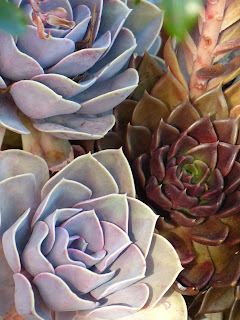ECHEVERIAS FOR EVERYONE
They come in a range of sizes from small multi-headed varieties to taller and larger plants. A lot of excellent varieties are available on EBay and shipped bare rooted. Some are quite rare and are harder to grow than old-fashioned garden bed varieties. There are too many varieties to treat individually so I will treat the genus generally for horticultural care:
1. Echeverias like to be elevated because in the wilds of Mexico many grow in mountainous terrain among rocks with plenty of air circulation. Raised pots and troughs tend to produce healthier and more colourful plants. This lowers the humidity in the micro-climate and keeps the leaves healthy.
2. A pocketful of soil is often key to preventing your
plants from rot and over watering. In the wild Echeverias grow in tiny pockets
of soil on sometime sheer rocks where rainfall runs away quickly .
In winter it is ideal to keep plants dry in the cool by moving
them undercover if possible.
In summer Echeverias take water once or twice a week but need
to dry out again quickly.
Keep the pot size small and re-pot only when the root space
is crowded , some larger heavier varieties will topple over unless they are in
a heavy pot.
3. Loads of sunlight leads to compact, colourful and healthy plants. Echeveria leaves rarely burn in the sunlight if they are well watered in summer. Varieties that have larger leaves sometimes need morning sunlight but afternoon shade.
4. Fertilise in the warmer months regularly. I recommend Osmosote slow release fertiliser once a year, and kelp extract fortnightly.
5. Watch out for aphids on the flowers, soapy water will work but Confidor will work better every 10 days.
6. Harvest any pups, remove them and pot them into a vermiculite mix in the semi-shade to grow roots and expand your collection...
Enjoy!










